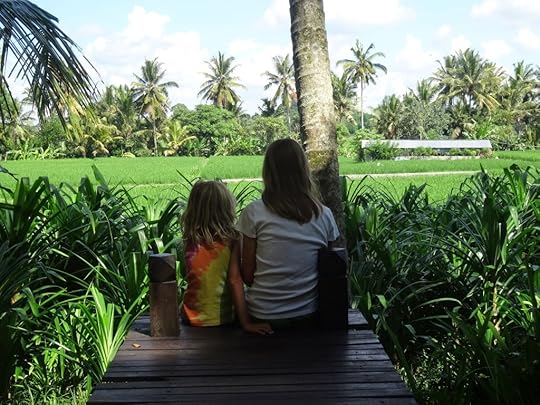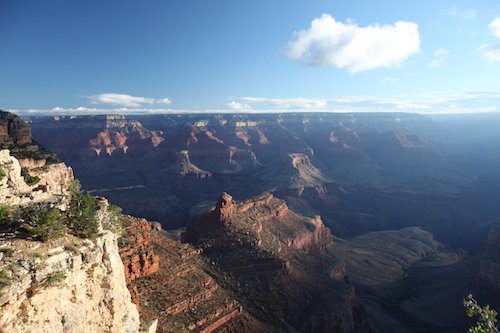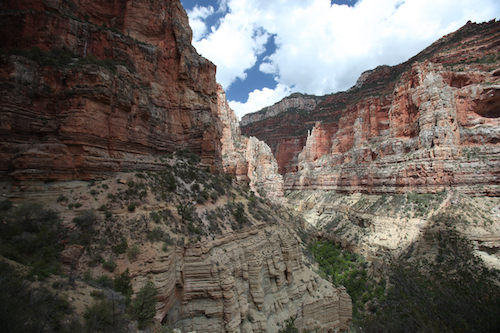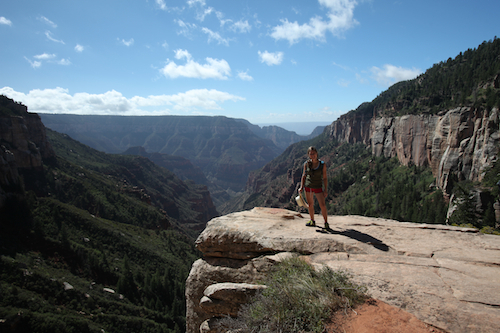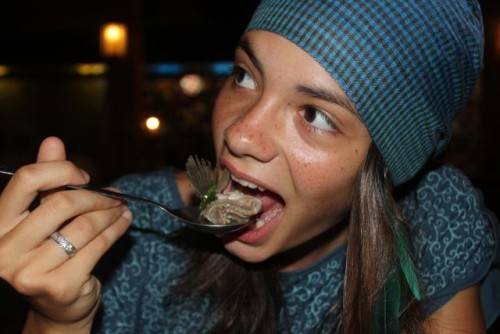Rolf Potts's Blog, page 26
September 30, 2014
Slowing down in Ubud, Bali
Vagablogging :: Rolf Potts Vagabonding Blog
Cost/day:
$28 per day per person
What’s the strangest thing you’ve seen lately?
There are many interesting and strange things to see on Bali, but if I had to pick just one it would be the statues you come across in seemingly random places.
Describe a typical day:
Our morning routine stays the same wherever we are. We wake up, make breakfast and do work and homeschool.
After that we typically would go explore an area, temple, mountain, beach, etc. via motorbike. The countryside in Bali is so bright green and beautiful that we would often take longer routes to our intended destination just to see more of it.
Evenings we would relax, make dinner and simply enjoy the tranquility of being surrounded by rice fields.
Describe an interesting conversation you had with a local:
I went to a birthday party for an eighteen-year-old local, Wayan. I talked with his friends and teenage family members for a while and had few shots of whatever local drink they were consuming. Unlike the other times when I’d been with Wayan, where we talked about an array of things, I barely spoke with him.
When I arrived, he sat me down with his cousin, gave me food and a drink and explained that he now would be attending to the others at the party. For the rest of the two hours I was there he spent that time making sure everyone, including me, had enough to eat and drink. He served people at his own birthday party. I have no idea if this is normal in Balinese culture, but I found it incredibly endearing. Certainly a drastic difference to how I, ahem, behaved on my eighteenth birthday.
What do you like about where you are? Dislike?
There is so much to like about Ubud. I liked the people. We met so many kind and smiling people. I liked the amazingly beautiful temples and natural environment. I liked the traditions that were on display with so many aspects of life, from daily offerings (see picture below), to decorating temples, parades and ceremonies, one of which happened in the middle of the rice field where we stayed. After being in southeast Asia for several months, I really liked the ability to get clean, organic food.
I disliked the traffic in Ubud. It is horrendous on some days. Too many buses on tiny streets causing massive traffic jams. It is not fun inhaling diesel exhaust on a motorbike. I disliked how touristy Ubud is. It is touristy in a different way than is the south of Bali, which is a beach destination, but it is touristy nonetheless.
Describe a challenge you faced:
We planned to spend a month in Ubud. It actually took about a week of settling down to enjoy the slower pace of life. After having moved every 3-5 days for so many months, being able to relax and not plan our next destination took some adjustment. I guess it was just a feeling of being restless. But in the second week I settled in and had no problem whatsoever enjoying my time there.
What new lesson did you learn?
That I need a break from traveling sometimes. It is so easy to try to see everything in a country. I just had to except that I cannot see it all and to attempt to do so will only lead to burn out, which I was until we recuperated in Bali.
Where next?
Penang, Malaysia
Original article can be found here: Slowing down in Ubud, Bali
September 29, 2014
Living “greener” on the road
Vagablogging :: Rolf Potts Vagabonding Blog
One of the things we worry about a lot as we travel is our carbon footprint; our environmental impact.
Living in the west where most people are mindful of the 3 R’s (Reduce, Reuse, Recycle) and most communities have “green initiatives” it’s easy to be lulled into complacency and think that we’re “doing it.”
Then, you enter the third world. Much of Asia, Africa and Central America are strewn, as far as the eye can see, with plastic bags, foam food containers, mylar packaging from juice containers and a sea of broken glass. Trash is a huge problem, worldwide.
As travelers, there’s another level though. How we move around the planet matters. There are “better” and “worse” ways to make a move. Airplanes are the absolute worst when it comes to carbon footprints. Every time I step onto a plane I hear the earth wheeze and I hate it. Sometimes we do it, but I hate it. It’s a hard balance to strike, between time, money and ecology, and I’m the first to admit that we could do better. We’re always striving to do better. Here are a few things to think about as you travel, either locally, or abroad:
The hierarchy of “bad travel”
Any vehicle burning a fossil fuel is “bad” on some level for the environment. Boats with little outboard motors, to big 737s all have an impact, but their impact is not equal.
Airplanes are the worst, I already mentioned that.
Big ocean ferries or cruise ships are also not great; the sheer volume of fuel burned and belched into the air or sea is hideous.
Cars with only one passenger are also a big waste (fill every seatbelt and the per person impact diminishes exponentially!)
Mopeds are better.
Small boats are better.
The hierarchy of “good travel”
Obviously this includes anything not burning a fossil fuel:
Boats without motors
Bicycles
Walking
Animal drawn carts
You get the idea. The thing to consider in this category is just what went into making what you’re using to get around. A brand new carbon fiber bike has a bigger footprint than upgrading an old used one that can be repurposed. Living car free and intentionally living within walking distance of everything that matters is better than riding a moped every day.
Baby steps.
Dealing With Trash As We Travel
Trash is the bane of my existence. I absolutely HATE to throw stuff out. It drives me crazy not to have a recycling program. Not having a compost bin seems just ridiculous on every level. It would be so simple. And yet, some places, these things just don’t exist.
What’s a traveler to do?
Buy less
Buy in bulk (reducing packaging) when you can, I realize this is hard living out of backpacks
Buy from bulk vendors in smaller quantities
REFUSE BAGS. Everything in Asia is slammed into two or three plastic bags per item, don’t take them, use your own cloth bag.
Stop buying small water bottles. They litter up the planet something fierce. Buy the big, returnable 5 gallon ones when you can and refill your reusable ones!
Ask Locals
Often there are options available that aren’t “advertised” when you arrive.
Example: There is no “recycling” program where we lived in Thailand, however, if you clean and separate your glass and metal and put it out next to your trashcan, there are folks who come around, pick it up and sell it for money. This helps the environment and the local economy, everyone wins!
Buy Local
The fastest way to reduce your carbon footprint, regardless of where you live is to buy local. For travelers, this should be a no brainer. The whole point of travel is to experience new places, new flavours, new ways of living.
Resist the urge to visit that big chain store and buy your Western comfort food. Eat local instead.
Don’t insist on brand name clothing that’s been shipped around the world twice, buy a locally made shirt or shoes.
The benefit is two-fold, the earth thanks you, and so does your neighbour who you purchase from!
What are your best tips for living green at home or on the road?
Original article can be found here: Living “greener” on the road
September 28, 2014
Tourism has a way of spoiling the unspoiledness you are there to experience
Vagablogging :: Rolf Potts Vagabonding Blog
“I confess that I have never understood why so many people’s idea of a fun vacation is to don flip-flops and sunglasses and crawl through maddening traffic to loud hot crowded tourist venues in order to sample a ‘local flavor’ that is by definition ruined by the presence of tourists. This may (as my Festival companions keep pointing out) all be a matter of personality and hardwired taste: The fact that I just do not like tourist venues means that I’ll never understand their appeal and so am probably not the one to talk about it (the supposed appeal). But, since this note will almost surely not survive magazine-editing anyway, here goes: As I see it, it probably really is good for the soul to be a tourist, even if it’s only once in a while. Not good for the soul in a refreshing or enlivening way, though, but rather in a grim, steely-eyed, let’s-look-honestly-at-the-facts-and-find-some-way-to-deal-with-them way. My personal experience has not been that traveling around the country is broadening or relaxing, or that radical changes in place and context have a salutary effect, but rather that intranational tourism is radically constricting, and humbling in the hardest way — hostile to my fantasy of being a real individual, of living somehow outside and above it all. (Coming up is the part that my companions find especially unhappy and repellent, a sure way to spoil the fun of vacation travel:) To be a mass tourist, for me, is to become a pure late-date American: alien, ignorant, greedy for something you cannot ever have, disappointed in a way you can never admit. It is to spoil, by way of sheer ontology, the very unspoiledness you are there to experience. It is to impose yourself on places that in all noneconomic ways would be better, realer, without you. It is, in lines and gridlock and transaction after transaction, to confront a dimension of yourself that is as inescapable as it is painful: As a tourist, you become economically significant but existentially loathsome, an insect on a dead thing.”
–David Foster Wallace, Consider the Lobster, Gourmet, August 2004
Original article can be found here: Tourism has a way of spoiling the unspoiledness you are there to experience
September 27, 2014
Book Review VANISHING TALES FROM ANCIENT TRAILS by James Dorsey
Vagablogging :: Rolf Potts Vagabonding Blog
VANISHING TALES FROM ANCIENT TRAILS by James Dorsey, 2014, Vagabundo Magazine Publishing. Buy on Amazon.
 When I first found his writing on celebrated travel webzine Perceptive Travel, there was one thing that made me an instant James Dorsey’s fan. It was the amount of literary adrenaline he was able to inject straight into readers’ eyes with the opening three lines of each and every story. Indeed, James would pull out his wordy meathook, and catch you right under the chin, pulling you into the action. You would feel the smells, sounds and fear he was trying to tell you all about. I don’t know why, but one of his simplest descriptions, “Akira tells me to follow him closely and I am practically in his back pocket” stayed with me until today: now, whenever I tell people to stay very close to my back, I tell them to “stick to my back pocket”, and I think of Dorsey’s time in Cambodia.
When I first found his writing on celebrated travel webzine Perceptive Travel, there was one thing that made me an instant James Dorsey’s fan. It was the amount of literary adrenaline he was able to inject straight into readers’ eyes with the opening three lines of each and every story. Indeed, James would pull out his wordy meathook, and catch you right under the chin, pulling you into the action. You would feel the smells, sounds and fear he was trying to tell you all about. I don’t know why, but one of his simplest descriptions, “Akira tells me to follow him closely and I am practically in his back pocket” stayed with me until today: now, whenever I tell people to stay very close to my back, I tell them to “stick to my back pocket”, and I think of Dorsey’s time in Cambodia.
This is the best quality I admire in Dorsey’s writing: his simple, dry, straight forward and damn catchy list of words that one after another “dance on the page”, as Bukowsky put it. But in this case, they dance at the sound of tribal drums during a secret and ancient ritual consumed under a moonlit forest thicket. VANISHING TALES FROM ANCIENT TRAILS is a collection of Dorsey’s new and previously published short stories documenting 30 years of forays into the known and lesser known paths of Asia, Africa (prominently), and elsewhere. Whether he’s recounting his time demining a Cambodian field, visiting a Shaman in the Amazon, tracking back a Masaai PHD student from America to Kenya, or overnighting with the Mursi tribe of Ethiopia’s Omo valley, Dorsey comes always across as a modest, tenacious, and eagle eyed explorer. What I like about this book is its down to earth spirit which can be epitomized by some of Dorsey’s own introductory words: “Like most naïve young travelers, when I first stepped out that doorway into the vast world, I was full of hopes and dreams, convinced that at some remote time or place a great sadhu or shaman would impart the knowledge of the universe to me as a true seeker. While I learned no great secrets along the way, I do believe I got just a tad wiser with each trip, and have no doubt that many of the people whose stories I collected are much further along the path to enlightenment than I am. People are the same the world over, but it is their stories that make them fascinating.” It may be because of his more mature age and the less flamboyant attitude I find in other younger travel writers, but by having gotten “wiser”, as he puts it, Dorsey instantly attracts the reader’s sympathy and support.
VANISHING TALES FROM ANCIENT TRAILS reads fast and easy as it is a collection of magazine-size stories, and also because of the many excellent black and white photographs Dorsey took around the world, which lure the reader further in. There’s a good balance of extreme adventure and culture shock that leads to cultural understanding, quasi-anthropological explanations, and pure thirst for wild adventure.
However, the small downside of this book is that, like most other short story collections, the quality floats. In this regard, I believe Dorsey should have avoided inserting too many of the shorter pieces, especially those centred on his fellow travel partner and wife Irene. I believe they are far too short and kind of out of focus from the rest of the excellent narrative flow, which is expertly centred on the outside critical view, and mostly because Irene is not prominently described as a proper character in none of Dorsey’s pieces.
Besides this glitch, I believe that VANISHING TALES FROM ANCIENT TRAILS does exactly what it sets off to: enchant and educate the reader with engrossing narratives from very exotic locations around the world. That’s the job of an explorer, and one Dorsey seems quite good at. I hope that next Dorsey will try to write a longer, novel sized narrative, trying to bring all the pieces of his dramatic travel puzzle together in a spectacular fresco, rather than leave them to the readers to pick up as they please in capsule-sized bits of reading.
Original article can be found here: Book Review VANISHING TALES FROM ANCIENT TRAILS by James Dorsey
September 26, 2014
The Dark Side of Travel Romance
Vagablogging :: Rolf Potts Vagabonding Blog
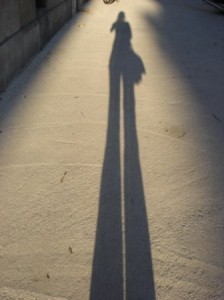 When it comes to the ways of love and romance, no aphrodisiac is quite so potent as travel. On the road — freed from the dull routines and restrictions of home — you become more open, more daring, more willing to seize the moment. Away from home, the people you meet (be they locals or fellow travelers) seem sexier, more exotic, less repressed — and this makes you feel sexy, exotic, liberated. Freed from your past, happily anonymous, and filled with a sense of possibility, you are never more willing (or able) to fall headlong into a love affair.
When it comes to the ways of love and romance, no aphrodisiac is quite so potent as travel. On the road — freed from the dull routines and restrictions of home — you become more open, more daring, more willing to seize the moment. Away from home, the people you meet (be they locals or fellow travelers) seem sexier, more exotic, less repressed — and this makes you feel sexy, exotic, liberated. Freed from your past, happily anonymous, and filled with a sense of possibility, you are never more willing (or able) to fall headlong into a love affair.
The only downside is this: Rekindling things when you get home almost never works. Regardless of how great you and your lover felt in Rio; regardless of how seamlessly the two of you bonded in Paris; regardless of the memories you cherish from Koh Samui, you are risking heartbreak if you try to resume the romance in Hackensack or Burbank or Minnetonka.
I used to wonder why this was the case — why, after sharing intense travel experiences, my relationships with the intriguing women I met in Cuzco or Tel Aviv would sour into a series of uninspired emails, awkward phone calls and (on occasion) anticlimactic reunions. Why would everything change once we’d stopped traveling?
I finally got a clue to the problem several winters ago in Thailand, when I met a Belgian lass I’ll call Katia. Willowy and doe-eyed, with a sexy pout and effortless European grace, Katia would have been out of my league back home — but in the colorful madness of Bangkok, we somehow fell into an easy love affair. Together, we took a train down to Khao Sok National Park in southern Thailand, where we stayed in a tree-house hotel, swam the jungle-rivers, drank Mekhong whiskey, and shared the stories of our lives. After a week, when it came time for Katia to fly back to Brussels, I felt like we had really connected — that our time together had amounted to something special.
Katia must have felt the same way, since — over the course of the next several weeks — she told me how much she missed me, how much she cared for me, and how much our time together had meant to her. When she eventually invited me to join her in Brussels for Christmas, I didn’t hesitate: I bought a plane ticket and flew out as soon as I could.
Once I arrived in Brussels, things fell apart almost immediately. When I tried to put my arm around her as we walked to meet her friends at a bar, Katia curtly warned me not to touch her in front of her friends (“They know I’m not sentimental like that,” she told me). Once in the bar, Katia continually scolded me: for eating too much; for not sitting up straight; for not asking her friends the right kind of questions. For some reason, I’d suddenly become an embarrassment to Katia — an uncultured American fool who couldn’t do anything right.
The disappointment went both ways: Back in Thailand, Katia was laid-back and affectionate, and she’d talked about her passionate calling to design jewelry; in Brussels, I’d quickly discovered that she was a shrill busybody who used her art studio mainly to play computer games. When we visited Belgian museums, Katia sneered at my ignorance of art history; when I read a book on the train to Louven, she scolded me for not looking out at the scenery; when we ate dinner with her parents, she lost her temper when I didn’t pay enough attention to the conversation (which, I reminded her, was mostly in Dutch). In Thailand, Katia had found pleasure in the simplest moments; in Brussels, the only times she seemed remotely satisfied were when we were arguing.
After a week of being trapped in a small Brussels apartment with Katia, I had a realization: despite everything that had happened between us in Thailand, she was still complete stranger to me. I had fallen for Thailand as much as I’d fallen for Katia, and she had done the same. The world we’d experienced together as travelers was, in many ways, a transient fantasy world — and the mountaintop experiences we’d shared in Asia amounted to a sandcastle by the time I’d arrived in Europe.
Indeed, if the anonymity and renewal of travel makes love bloom easier, returning to the noise of your home-life makes road-romance reunions that much harder. Despite all the memories you’ve shared on the road, you can’t pick up the relationship where it left off, because that place is now thousands of miles away.
Last summer, after having not communicated for four years, Katia sent me an email suggesting we meet up and talk. We met — as friends — in Paris, and I felt like I got to know my old Belgian lover for the first time.
[This Rolf Potts article originally appeared in Yahoo! News on Apr. 10, 2006. All rights reserved.]
Original article can be found here: The Dark Side of Travel Romance
September 25, 2014
Vagabonding Case Study: Norbert Figueroa
Vagablogging :: Rolf Potts Vagabonding Blog
Norbert Figueroa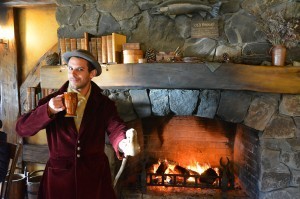
Age: 31
Hometown: Carolina, Puerto Rico
Quote: The world is a book and those who do not travel read only one page. – St. Augustine
How did you find out about Vagabonding, and how did you find it useful before and during the trip?
The site has some good tips on long-term travel as well as informative destination posts. I actually bought the Vagabonding book for kindle a few months ago, but I have to admit that I’ve been a bit lazy and busy, so haven’t finished it yet. Will do soon! I promise.
How long were you on the road?
As of today, I’ve been on the road for 3 years. Still planning on going for as long as I can.
Where did you go?
It’s been 86 countries so far, in 5 continents, with the last couple countries being Thailand, Sri Lanka, Brunei, Malaysia, Maldives, Australia, New Zealand, Indonesia, and Laos.
What was your job or source of travel funding for this journey?
For the moment it is my blog and freelance travel writing. Apart from that, I’ve used my savings from my previous job as an architect.
Did you work or volunteer on the road?
I’m a licensed architect in New York, so I’ve done a few small gigs on the road, but I’ve found out they are too time consuming, so I’ve stopped doing them for now. Other than that, the blog is my passion and “work”. Volunteering is still on my list. In fact, I want to donate my architectural services to NGOs looking to improve their infrastructure. I have one in mind and we are currently discussing the project. Hopefully it will work out.
Of all the places you visited, which was your favorite?
Really hard to pick just one, but I’ll go with Thailand. It is the first country I backpacked solo and one that offers such a good cultural variety as well as so many different travel styles and beautiful places to visit. Plus, their food is delicious. As good runner ups I have New Zealand. That country is extremely beautiful!!! I can’t wait to go back to New Zealand!
Was there a place that was your least favorite, or most disappointing, or most challenging?
Oh yes… India was the most challenging and it would have been my least favorite if I didn’t happen to travel to the Himalayas, which was the only part of India I really liked. But, Ukraine for me was totally disappointing and probably my least favorite right now.
Which travel gear proved most useful? Least useful?
It’s not exactly a travel gear, but my iPhone is the most useful thing I have right now. I use it for everything! Least useful would be my x-mini speaker. Been carrying it for over two years and I can count with one hand the times I’ve actually used it.
What are the rewards of the vagabonding lifestyle?
The freedom of doing what you really want and like and the immense personal growth through the challenges that do come every now and then. You learn so much through different cultures and people. I try to soak it all up like a sponge.
What are the challenges and sacrifices of the vagabonding lifestyle?
One of the main challenges for me is the personal relationship with friends and family. It’s hard to always stay in touch and be synched as before. You make a lot of friends on the road, but only a few (at least in my case) are the ones truly make that “good friends” connection. And well, making a living is hard too, so sometimes it’s a challenge to find a good place with good wifi where you can concentrate on work.
What lessons did you learn on the road?
To have a lot more patience and to understand better other people’s point of view and customs (especially when I’m in a country where things are completely different from what I’m used to). In addition, I’ve learned to manage my money better or at least I think I did!
How did your personal definition of “vagabonding” develop over the course of the trip?
I used to travel faster in the beginning (I wanted to see everything!), now I go slower and go a bit deeper in to the country and culture than before. I still want to see everything, though.
If there was one thing you could have told yourself before the trip, what would it be? Why didn’t you do this sooner?
Any advice or tips for someone hoping to embark on a similar adventure? Taking the leap is scary, but if you truly believe in the journey you want to do, don’t let anything stop you. Things have a way of working out for you in one way or another. If you’re scared of doing it, buy that first plane ticket to anywhere. Once you have it, it will feel so much real and you’ll feel like you crossed the point of no return.
When and where do you think you’ll take your next long-term journey?
I’m still in this journey, so the next few countries I’ll visit will be mostly in South America, and hopefully Antarctica!
Read more about Norbert on his blog, Globo Treks , or follow him on Facebook and Twitter.
Website: Globo Treks
Twitter: @globotreks
Are you a Vagabonding reader planning, in the middle of, or returning from a journey? Would you like your travel blog or website to be featured on Vagabonding Case Studies? If so, drop us a line at casestudies@vagabonding.net and tell us a little about yourself.
Original article can be found here: Vagabonding Case Study: Norbert Figueroa
September 24, 2014
Reaching the bottom of the Grand Canyon
Vagablogging :: Rolf Potts Vagabonding Blog
As magical as the Grand Canyon is from the top, peering down into red and purple shades of rock so far down your eyes lose an ability to judge the distance, it is yet more magical from the very bottom peering up. Perhaps because of the feeling of accomplishment that comes from a journey down, and perhaps from a feeling of quiet, peaceful seclusion from the modern world.
Whatever the reason, it’s well worth a trek down just to spend the night at the bottom in either Phantom Ranch or nearby Bright Angel Campground. It may not feel that way as you wade through the tedious reservation process for Phantom Ranch, but that is not the logistical detail I’ll be going over in this post.
In this post, I’d like to give a little bit of insight for potential hikers trying to decide which trail to take, as there are 3 major trails leading down to the bottom, North Kaibob, South Kaibob, and Bright Angel Trail. Having hiked the entirety of each of these trails at some point, I’d love to give a hiker’s perspective.
Bright Angel Trail
Distance to Phantom Ranch: 9.9 miles
Access points: Phantom Ranch and Grand Canyon Village at the South Rim
Bright Angel Trail is probably the easiest trail to recommend because of its frequent water stops and moderate distance. Hikers who are not interested in going all the way down to the bottom of the canyon can hike down to the Indian Gardens region 4.9 miles down instead.
But what this trail is especially good for is the journey back up, regardless of which trail you’ve taken down. While it’s not the shortest of the trails we’ll talk about, it is the shortest one with water stops. Both of these details are extremely important for an upward journey. Hiking up the canyon can take significantly longer than hiking down and can be far more fatiguing.
The atmosphere of this trail is interesting as well. It will lead you through a quintessential red-rock desert type of environment until you reach the lush area of the Indian Gardens. After this point, you descent towards the river and complete the last part of your journey walking alongside it.
South Kaibob Trail
Distance to Bright Angel Campground: 7.1 miles
Access points: Bright Angel Campground and Yaki Point along the South Rim.
I chose this for an ascending hike one year and it was the most difficult Grand Canyon hike I’ve done. It is steep, has no water stops, and leads you through a dry, winding cliffside that offers little relief from the sun at times. Hikers who choose this route should be very intentional and realistic about the supplies they pack with them. It is indeed a shorter hike, as the shortest of the trails we’ll mention today, but the most strenuous one, so take this into account.
I recommend this trail mostly for descending. Particularly if a person is concerned about making it to the bottom in time for a scheduled dinner. (All meals at phantom ranch must be reserved and fall into a strict schedule). And while it’s not impossible to use this trail for ascending, it’s not to be taken lightly.
North Kaibob Trail
Distance to Phantom Ranch: 14 miles
Access points: Phantom Ranch and the North Rim Trailhead.
I chose this one to discuss last because it is my favorite, and I’d like to share a piece I wrote about it after hiking it last month.
But first, the logistical details: This trail is the longest of those mentioned today. Significantly so. And yet, it is not a strenuous 14 miles comparatively. It is not as steep, and the environment transitions frequently. There are plenty of water stops and as long as you are providing a realistic amount of time for the hike (anywhere from 5 – 9 hours), this is a wonderful choice for a descending hike. Anyone considering this hike for the ascending trip should remember that ascending hikes take significantly longer than descending.
This is not a very popular trail, as the only trail leading up to the North Rim, but I’d like to reference the thoughts I made in a post last month to advocate for this trail as a favorite.
“The North Rim is quiet. If you stand and listen for a moment you don’t hear the chatter of a high traffic tourist destination as you would on the South Rim. Instead you hear the wind through the pines. In fact, the beginning of your trek does not feel like quintessential Canyon red rock dust and desert. Instead you’re in a gentle pine forest. In fact the first stretch of the North Kaibab Trail hike begins in this setting until the vegetation shrinks back and you can see the height of the cliff you’re standing on. The view opens up and you make your way down along cliffs into the floor of a side canyon. And then the landscape changes again. Every few miles, in fact, the landscape of the North Kaibab seems to change into something new as the canyon walls rise around you, layering back until the rim disappears behind the cliffs nearest your path.
These early miles of the trail find you descending through an ancient solidified display of the earth’s history- a core sample of the layers of earth in front of your very eyes till you reach the most ancient layers of subtly glittering Vishnu Shist, so ancient it lacks any traces of organic, biological matter. This amazing artifact of geological history lines the later miles of the trail like gravel, kicked along humbly by the feet of hikers.
This is also where you reach a little canyon creek that slips like melted glass through desert rock and brings green life wherever it goes. Most of the remaining 7.2 miles of the North Kaibab follow this creek. As I looked at it, I wondered at how different it seemed from the forest creeks I grew up with in Ohio, clouded with decaying plant life and stirring up mud. This water, cupped by canyon rock seemed more pure and more lively. And the plants that line the banks are so foreign to someone who grew up far from the desert. Prickly, spiny, spindly little plants keeping themselves as inward as possible, not spilling out clumsily into one another like the leaves and grasses of the east. Orderly, linear plants.
The creekside portion of this trail levels out significantly and you find yourself anticipating each bend will reveal the little cabins of Phantom Ranch.
It’s always further than you think. But I don’t mind in that environment. Even tired and hungry, I’m happy to be there.”
Original article can be found here: Reaching the bottom of the Grand Canyon
September 23, 2014
Vagabonding Field Report: Blue Mountains and a full English
Vagablogging :: Rolf Potts Vagabonding Blog
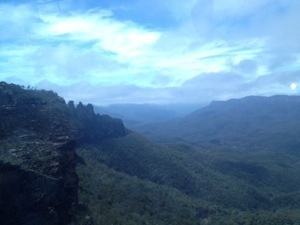
Cost/day:
We chose to do the blue mountains as a holiday getaway, so we invested a little more in accommodation and opting to eat out each night.
We found an affordable accommodation about 6 kilometres from central katoomba, The Skyrider Motel. It cost $100 a night a little over our usual expenditure but worth it for the luxury of one of the comfiest beds I think I may have ever slept on.
We searched some of the local bars and restaurants for a good meal, again lossening the belt around our budget. Most meals per person could range from a $15 pub grub special to upwards of $40 for a sit down dining experience.
Describe a typical day:
It felt like a chore getting out of such a beautiful an comfortable bed but we rose nice and early and set out for breakfast.
A small independant cafe in the heart of Katoomba offered a range of breakfast dishes from a bowl of muesli to a full English breakfast. So I opted in for the latter which I washed down with a fresh cappuccino. The cafe had a great vibe, the walls pasted with old rock posters and bank notes from around the world. It was run by what seemed to be fellow travellers, who kept the eatery lively and vibrant. It was Coffee with smile.
Once stuffed on sausage, beans and eggs we went in search of the local tourist center. I weighed up the idea of taking a tour or going it alone. Later choosing to make our own way round the scenic mountainous site.
So we purchased an all day pass for the Scenic World, this allowed us on the several attractions that offered the many views of the valleys and mountains.
A tip for any would be travellers to Katoomba from Sydney, it’s worth buying a 3 day public transport pass. Not only can you use it around Sydney on all public transport but it can take you out to Katoomba by train and allow you to use all public transport here also.

So we hopped on our designated bus and took it to Scenic World’s Skyrail. This is a cable cart with a class bottoms that takes your over the beautiful gorge. Be wary the cue was long for little reward however it did give a perspective of the depth of the gorge below.
Jumping off the other side we chose to walk along the footpath that takes you along the Gorge with a promise of a view of the 3 sisters, A trio of rock spires that stand out from the cliff face. It’s a long walk but many vantage points give a beautiful view of the blue mountains. A tremendous vastness of green forestry, rock faces, all clouded in a blue haze of which the area gained its name.

The beautiful sight of these 3 three rock formations didn’t disappoint, we stood and took in the moment for some time. Taking in every crevice, jagged rock that made up theses 3 sisters of rock.
Once finished a short bus ride took us to another beautiful site, only this time we would have to walk for 45mins down into the gorge. We were making our way down to the Katoomba Falls waterfall. For us we knew this would be a beautiful picturesque platform but what we found was more astonishing than we could have estimated.

The platform was a flat rock that led to a cliff edge. On one side if us was the beautiful cascading waterfall, spin 180 to an amazing panoramic of the blue mountains. Just when we thought we had seen a beautiful view from the top of the gorge, suddenly it felt like we had been transported to a secluded paradise. The long steep boggy walk down made this spot quiet with only a small many sharing the spot with us.
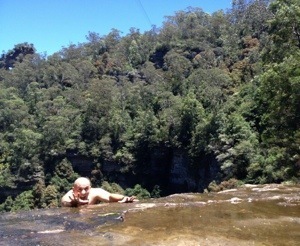
We splashed around the water for a while enjoying the relaxing soothing sounds of the crashing water. We could have stayed here all afternoon but we had to make our way back to the top. We stopped at several lookouts along the route back up. Then finally reaching the the busy road above we set out for a nice eatery.
The bus dropped us outside the old City Bank. This quaint 2 story pub was bustling with travellers and boasted a bohemian atmosphere. Before we stepped through the door we had decided where we would spend the evening. With a little taste of home Guinness flowed from the taps and helped wash down the delicious homemade burger. Bacon Cheese and a 3/4 pound if meat, complimented by the hand cut chips and a touch of BBQ sauce. We drank until the last bus that took me back to the comfort of that beautiful bed.
What do you like about where you are? Dislike?
The Skyrider Motel was a complete surprise, from the outset it seemed like a pay by the hour Bates motel. However once inside, the room is a cosy well equipped room. The couple that ran the motel are also friendly and very helpful.
The blue mountains and the surrounding areas themselves are a beautiful sight to behold and was worth every cent and every second spent there.
The only downside is the World pass. The glass bottom Skyrail we did on the first day and the Skytrain really aren’t worth the money. Long waits in quiet season for crowded bustling carts gave little reward. Above all of this, once you reach the bottom of the valley you can only walk back up, there is no option to return to back of the cue. As able bodies explorers we were happy to walk back up but for anyone who may be impaired I could imagine this to be a burden.
Describe a challenge you faced: We really underestimated the walking trail to the Waterfall, it is very steep and in some places boggy and flooded. Our real mistake was deciding to wear our flip flops. We struggle more than most but we never gave up and it was worth the struggle
What new lesson did you learn?
Always be prepared, a good pair of walking boots will never fail you no matter how much you like the wind between your toes.
Where next?- It’s magnetic island
Original article can be found here: Vagabonding Field Report: Blue Mountains and a full English
September 22, 2014
5 Ways to eat healthy while traveling
Vagablogging :: Rolf Potts Vagabonding Blog
Eating healthy is important to us.
I’m a relentless “do it myself” sort of girl. I was raised freezing and canning a lot of our own food. I make most things from scratch. It’s really important to me to feed my family healthy things so that the children grow properly and so that healthy eating patterns are established for life.
Lots of people ask us what we do about that while we’re traveling, since traveling is a lifestyle, not a two week event. There’s not one answer to that and there’s no easy answer. We’re in continual renegotiation of nutritional terms in this family. The most basic answer is that we do the best we can with what we have on any given day, on any given continent. The following are five of our strategies:
Eat Fresh
Most nutritionists will agree that fresh food and raw food are the most healthful choice. We eat as much fresh food as we can. Of course in many of the places we choose to live this also means adhering to the bleach-boil-peel rule. We’ve replaced “bleach” with Grapefruit Seed Extract (GSE) as a more natural fruit and veggie wash and we carry a knife in our backpack for a quick fruit peel while walking in a market.
With GSE we’re even able to make salads (often cited as a no-no in third world places because of the water used to wash the lettuce) daily.
For us, the best way to stay healthy is to eat lots of fresh fruits and vegetables and enjoy the fabulous diversity of the planet. One of the best parts of travel is the food!
Eat Local
Eating Local means eating things grown or produced within the region we are living in. We don’t often buy pineapple when we’re living in Canada. We don’t often get apples when we’re living near the equator.
Eating local foods means that you’re also getting slow doses of the local bacteria, which will help build immunity as well as tolerance for the differences in diet and “gut bugs” as we travel. Moving slowly helps too, dropping in by plane is always an intestinal shock!
Lots of the guidebooks will tell you not to eat street food. We actually take exactly the opposite position. I would much rather eat a meal that I see cooked right in front of me than one cooked in a kitchen facility that I can’t see from the table where I’m seated. That way we know the food is hot and fresh and reasonable sanitation standards have been adhered to. There is nothing quite so local as food off of a street cart! Yum!
Make Our Own Probiotics
This is where you decide I’m crazy. In my backpack I carry cheese and yogurt cultures as well as water kefir grains. Yep. We make soft cheeses and yogurt out of dried milk and the first thing I do when we set up a new base is get my kefir grains going.
Travel naturally exposes us to a wider range of intestinal risks than living in New Hampshire did, and one of the ways we stack the deck in our favour is by making sure our guts are populated with the right kinds of bacteria!
Portable Nutrient Dense Greens
Believe it or not, it can sometimes be hard to come by fresh vegetables. We hit this wall immediately when we landed in Bangkok. There was a ton of street food available, but most of it was meat, wheat or rice based. We could get fruit, no problem, but we were quickly feeling the lack of veggies.
It sounds completely nuts, but I carry sprouting seeds in my backpack. It only takes a couple of days to get a batch ready and we love them. They can be added to salad, or made into the salad themselves. We love having almost instant access to high quality veggie sprouts and they make a big difference in our diet on the road!
Take Supplements
We take vitamins. Not religiously, but when we feel like our diet is not up to par, we add them in. We also carry essential oil and herbal concoctions to combat basic illness (oregano oil & rosemary oil) add vigor (spirulina), and sort out basic gut bugs (GSE).
What are your secrets for staying healthy and improving your nurtrition on the road, or at home?
Original article can be found here: 5 Ways to eat healthy while traveling
September 21, 2014
Ariel Levy on the anxiety that hits just before a journey begins
Vagablogging :: Rolf Potts Vagabonding Blog
“I always get terrified right before I travel. I become convinced that this time will be different: I won’t be able to figure out the map, or communicate with non-English speakers, or find the people I need in order to write the story I’ve been sent in search of. I will be lost and incompetent and vulnerable. I know that my panic will turn to excitement once I’m there — it always does — but that doesn’t make the fear before takeoff any less vivid.”
–Ariel Levy, “Thanksgiving in Mongolia,” The New Yorker, 11/18/2013
Original article can be found here: Ariel Levy on the anxiety that hits just before a journey begins
Rolf Potts's Blog
- Rolf Potts's profile
- 323 followers



